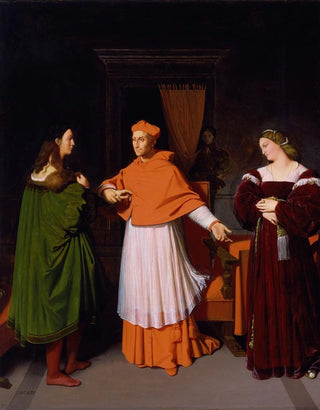Art print | The Engagements of Raphael and the Cardinal Bibbiena's Niece - Jean-Auguste-Dominique Ingres


View from behind

Frame (optional)
In the fascinating world of art, some works transcend their era to become timeless symbols of beauty and harmony. The art print Les fiançailles de Raphaël et de la nièce du cardinal Bibbiena, created by Jean Auguste Dominique Ingres, fits perfectly into this category. This piece, which evokes a historic encounter between the genius of the Renaissance and the classicism of the 19th century, captivates the eye and the mind with its rich narrative and refined aesthetic. By immersing oneself in this scene, the viewer is invited to explore the subtleties of human relationships and the nuances of social conventions of the time.
Style and uniqueness of the work
Ingres's style is immediately recognizable, characterized by precise contours and meticulous attention to detail. In Les fiançailles de Raphaël et de la nièce du cardinal Bibbiena, each character is depicted with a delicacy that highlights the beauty of their features and clothing. The drapery, with exceptional fluidity, seems almost alive, while the colors, carefully chosen, create a harmonious balance. The work stands out for its rigorous composition, where each element finds its place in a thoughtfully orchestrated arrangement. Ingres manages to capture not only the moment of the promise between Raphaël and the niece of the cardinal but also the atmosphere imbued with solemnity and tenderness surrounding this crucial moment. The light, playing on faces and fabrics, accentuates the emotion present in the scene, making this painting of rare intensity.
The artist and his influence
Jean Auguste Dominique Ingres, an emblematic figure of Neoclassicism, mastered the blend of tradition and innovation throughout his career. Trained at the Académie des Beaux-Arts, he was heavily influenced by Renaissance masters, notably Raphael, whose ability to combine formal beauty with emotional depth he admired. Ingres not only redefined the standards of historical painting but also paved the way for new interpretations of the human body and the representation of the female.

Matte finish

View from behind

Frame (optional)
In the fascinating world of art, some works transcend their era to become timeless symbols of beauty and harmony. The art print Les fiançailles de Raphaël et de la nièce du cardinal Bibbiena, created by Jean Auguste Dominique Ingres, fits perfectly into this category. This piece, which evokes a historic encounter between the genius of the Renaissance and the classicism of the 19th century, captivates the eye and the mind with its rich narrative and refined aesthetic. By immersing oneself in this scene, the viewer is invited to explore the subtleties of human relationships and the nuances of social conventions of the time.
Style and uniqueness of the work
Ingres's style is immediately recognizable, characterized by precise contours and meticulous attention to detail. In Les fiançailles de Raphaël et de la nièce du cardinal Bibbiena, each character is depicted with a delicacy that highlights the beauty of their features and clothing. The drapery, with exceptional fluidity, seems almost alive, while the colors, carefully chosen, create a harmonious balance. The work stands out for its rigorous composition, where each element finds its place in a thoughtfully orchestrated arrangement. Ingres manages to capture not only the moment of the promise between Raphaël and the niece of the cardinal but also the atmosphere imbued with solemnity and tenderness surrounding this crucial moment. The light, playing on faces and fabrics, accentuates the emotion present in the scene, making this painting of rare intensity.
The artist and his influence
Jean Auguste Dominique Ingres, an emblematic figure of Neoclassicism, mastered the blend of tradition and innovation throughout his career. Trained at the Académie des Beaux-Arts, he was heavily influenced by Renaissance masters, notably Raphael, whose ability to combine formal beauty with emotional depth he admired. Ingres not only redefined the standards of historical painting but also paved the way for new interpretations of the human body and the representation of the female.






